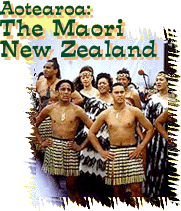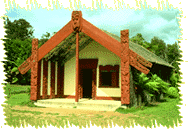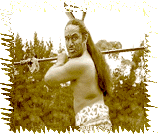 |
 |
 |
|
|||
|
Aotearoa: The Maori New Zealand
Thousands of years ago, long before Columbus and Cortez, tribal people were expertly navigating the great oceans of the world in double-hulled canoes. They were deeply spiritual people whose voyages were undertaken on the wings of karakia, or prayers, and their maps were the stars and celestial bodies. Today they are called the Maori, and they live in New Zealand. Although they are integrated into the rest of the country, they have a distinctive cultural heritage that is so rich and complex that its origins are not even completely clear to the Maori themselves.
Although travelers to New Zealand can enjoy spectacular scenery and meet many welcoming Kiwis, it's the discovery of the Maori people that offered me the deepest and most unique experience in this tropical paradise. And many Maori are willing to welcome visitors, like Pami, who gives us a singing lesson in his native language. The number one tourist attraction in New Zealand is a night at the Tamaki Maori Village, which has been specially constructed outside of Rotorua. Despite the whiff of Disneyland, it's a good generic introduction to the culture. The Maori were traditionally fierce warriors, and they meet us at the gate with menacing war chants and brandishing their long, sharp wooden spears called tiaha. A branch of green fern is tossed at our feet by a warrior in a flax skirt with moko, or tattoos, covering his face. If we pick up the green branch, it signifies that we come as friends. If we decline it, we declare ourselves enemies. Looking into the warrior's angry orbs, we hastily grab the fern. Inside the Maori village, fully-costumed Maori re-enact the lives of their pre-colonial ancestors--planting kumara or sweet potato, playing stick games, making wood carvings and tending fires. In the ornately-carved wharanui or meeting house, an exuberant Maori cast performs songs, dextrous digital manipulations with white balls called poi, and the eye-popping, tongue- lolling, meant-to-terrify war chants called haka. For something a little more intimate, the Kiel family in Rotorua invites visitors to eat with them and then sleep Maori style in their family wharenui. Mattresses line the floor and you pray your neighbor doesn't sleepwalk or snore too loudly. In their front yard, where flowers bloom and birds chirp, the Kiel women offer a powhiri, the traditional Maori welcome to their marae or gathering place. Women are not allowed to speak during the welcoming ceremonies, but the wail of their powhiri is the first sound to greet visitors. Then the men take over, with formal, oratorical speeches that are made by the hosts and then the visitors.
Roaring over the hills and along the beach, he stops at scenic spots and shares stories of the Maori ancestors. The high point, or lowpoint--depending upon your taste for the macabre, is when Tipo pauses in front of a large flat rock. Here he tells the tale of two rival warrior chiefs. When one was defeated and killed, the triumphant tribe wanted to get a little of his mana, or power. They indulged in a tradition that gave Mitimiti its name.
Rest assured that Tipo is a modern Maori with no penchant whatsoever for fresh human flesh. His taste runs more toward playing the guitar and singing for his foreign guests. In seaside Mitimiti, fish have always been a food staple. As the Maori say, when the tide is out, the table is set. If you ask, Tipo will take you fishing the old Maori way, and it is a rare treat which catapults you back into the Maori past. Carrying a long net, Tipo marches into the ocean, perfectly times the waves, casts his net, and in two minutes he wades back to shore with five huge, flapping mullet. Then we grill and eat them. How do they taste? Well...when our plates are empty, we dive in for another lick-lick, or mitimiti. Throughout the northland, seafood is part of the hospitality, but sometimes it's difficult to accept. A beautiful, gray-haired Maori woman named Miri stands on the wooden porch in front of her rustic home. She plucks and eats fresh shellfish from a plastic bucket.
I wonder what other delicacies she has in mind for dinner...like me, for instance?
A few hours from Mitimiti, in Paihia, Grace Edmonds, her husband Tomati and their 22 Maori grandchildren welcome you to the Pine Lodge motel, replete with a traditional dinner and full Maori performance by the little ones. They greet us with a hongi--by looking in our eyes and touching noses with us.
Next stop, about three hours from Pahia, is the Auckland museum. Here you can enter an authentic wharenui or meeting house, and gawk at the staggering amount of ancestral information carved into the entryway, wooden posts and walls of the building. Whakapapa, or geneology, is essential to the Maori. Most of the people I met can proudly tell you which of the famed wakas, or canoes, their ancestors paddled to New Zealand close to a thousand years ago. Some of the Maori can trace their ancestry back thousands of years. Grace Edmonds tells us about one of her cunning predecessors. At Waitangi, visitors learn about one of the most impressive treaties ever signed between European colonizers--or pakeha--and native people. The Maori were great strategic thinkers and they realized that the British were there to stay, and they had to co-exist with them. In l840, here on this grassy Waitangi plain which overlooks the ocean, over 500 Maori chiefs met with representatives of the British crown. As the director of the Waitangi Center explains it:
The Treaty of Waitangi, although it has often been broken by the pakeha, still governs all land, resource and reparation treaties that are ongoing today.
What's extraordinary about this marae--or gathering place-- is that it's smack in the middle of a museum but is still used for Maori ceremonies. If you're fortunate, one of your new Maori acquaintances will give you a piece of sacred pounamu, or greenstone. If not, my advice is to buy one yourself and wear it around your neck for luck, and to increase your personal mana, or power. It will be a also be a cherished souvenir from a faraway place where gentle, friendly, indigenous people are still connected to the glimmering stars, the briny sea, and the deep and abiding mysteries of the universe. This is Judie Fein, wishing you strong mana, for The Savvy Traveler.
|
 | American Public Media Home | Search | How to Listen ©2004 American Public Media | Terms of Use | Privacy Policy |

 How can all of these different migration stories be true? Some say "Maori"
may be a generic term like "American Indian," invented by the colonizers.
Even though the Maori today speak one common native language, they may
actually be diverse iwi or tribes that had different origins and migration
routes in the distant past.
How can all of these different migration stories be true? Some say "Maori"
may be a generic term like "American Indian," invented by the colonizers.
Even though the Maori today speak one common native language, they may
actually be diverse iwi or tribes that had different origins and migration
routes in the distant past.
 A day's drive from Rotorua takes you to the northern part of the North
Island of New Zealand. There, on a secluded beach called Mitimiti, a man
named Tipo Cash offers hostel-style accommodations and delicious home-cooked
food right next door to his own abode. Then he takes you out for an
adrenaline-charged ride in his eight-wheel vehicle.
A day's drive from Rotorua takes you to the northern part of the North
Island of New Zealand. There, on a secluded beach called Mitimiti, a man
named Tipo Cash offers hostel-style accommodations and delicious home-cooked
food right next door to his own abode. Then he takes you out for an
adrenaline-charged ride in his eight-wheel vehicle.
 Near Pahia, down at the docks, a charming local man offers swimming with the
dolphins, Maori style. He recounts tribal legends and blows a conch shell.
Then he illustrates how the powerful warriors cut off the tops of heads or
jabbed their long wooden spears called tiaha into the enemies' hearts. It
makes me proud to be a pacifist.
Near Pahia, down at the docks, a charming local man offers swimming with the
dolphins, Maori style. He recounts tribal legends and blows a conch shell.
Then he illustrates how the powerful warriors cut off the tops of heads or
jabbed their long wooden spears called tiaha into the enemies' hearts. It
makes me proud to be a pacifist.
 Our final stop is one of the jewels in the Kiwi crown--newly-constructed,
$380 million dollar Te Papa Museum in Wellington. Besides a stunning Maori
collection, there is a soaringly beautiful but very controversial
pastel-colored contemporary version of a wharenui, or meeting house. To me, it's like entering into Maori dreamtime.
Our final stop is one of the jewels in the Kiwi crown--newly-constructed,
$380 million dollar Te Papa Museum in Wellington. Besides a stunning Maori
collection, there is a soaringly beautiful but very controversial
pastel-colored contemporary version of a wharenui, or meeting house. To me, it's like entering into Maori dreamtime.